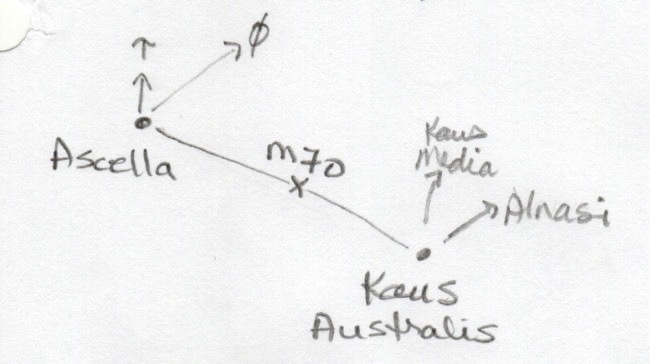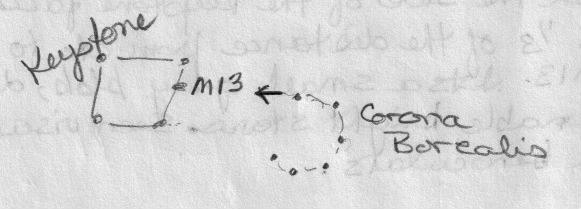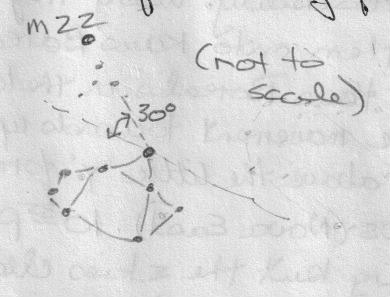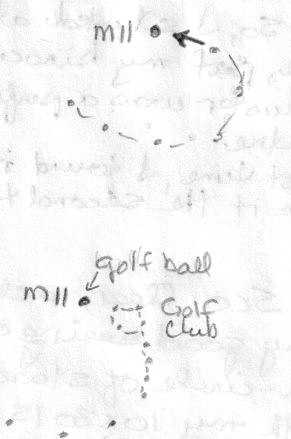Constellation: Cassiopeia, Corona Borealis, Delphinus, Scorpius, Ursa Major, Virgo
Asterism: Keystone of Hercules, Square of Pegasus, Teapot
Messier Object: M6 (Butterfly Cluster), M8 (Lagoon Nebula), M11 (Wild Duck Cluster), M13 (Hercules Cluster), M20 (Trifid Nebula), M21, M22, M25 (IC4725)
Planets: Jupiter, Saturn
Satellites: (2)
Failed Attempt to Find: M54, M58, M69, M70, Sagitta
Location: St. Croix Observatory (SCO)
Date: 2017-06-26 - 2017-06-27
Time: 9:50 PM - 1:30 AM
Temperature: 20° C - 18° C
Instrument: Visual + Binoculars 10x30 IS + Binoculars 15x70
Magnification: x10 + x15
Transparency: Excellent (5)
Seeing: Excellent (5)
Clear skies with only a few clouds. No wind. A few fireflies in the greenery near the shore. While Jerry was setting up his time lapse equipment, I was getting my bearings and determining the stars that rose in the night sky visually first.
However, my first order of business was to look at the Moon while it was still up high enough above the tree line at SCO. Not much time for Explore the Moon (Binocular) - June 26, 2017.
|
M70 |
 |
|
10:00 PM Given sky conditions on any given night, we appreciated that only one of these methods might be used. Tonight's excellent seeing and transparency meant both could successfully be used. |
 |
10:10 PM
For the second time in a month, Scorpius was well above the horizon and at about a 45° angle in the sky. θ and η were about 5° to 10° above the horizon; this was the brightest and highest I can recall seeing this constellation at home in Nova Scotia!
Adjacent to Scorpius was the Teapot (the asterism in Sagittarius). It, too, was at about 5° to 10° declination and was completely horizontal! Ascella and Kaus Borealis were level with the horizon and Kaus Borealis pointed straight up. Never saw it level before. Came close in Utah. All stars within the asterism were very easily located and identified.
10:15 PM - 10:26 PM
According to SkySafariPro, Jupiter was located in Virgo. Located Spica. Jupiter was bright and at a similar declination to Spica. Virgo seemingly wrapped her arm around the planet. Saturn was also visible this evening. Found Saturn adjacent to Antares in Scorpius.
10:42 PM
I noticed a satellite going across my visual field from West to East. My phone identified it as Taingong.
11:02 PM
Was looking in the general area of Virgo when an iridium flare caught my eye travelling SW to NE above Spica towards Jupiter.
11:16 PM
With the Teapot so high and level against the horizon, it was easy to find M6 (Butterfly Cluster) by going 1.5 FOV from Kaus Borealis.
11:18 PM
I decided that given Spica was so bright, I would use my S&T Pocket Atlas to identify the other stars in this constellation.
Not disappointed!
a) 109, τ, &mu:, and Syrma/ι were the first stars in addition to Spica that I could see.
b) Next came ξ, Vindemiatrix, Porrima. Vindemiatrix was particularly bright.

10:30 PM
Started at Kaus Borealis and followed a line to the midpoint in the spout, then the same distance to M8. M20 was just a little above M8 in the same FOV. This was not difficult to find given the excellent sky conditions.
10:37 PM
Could see all the stars in the Big Dipper naked eye; did not use binoculars. Polaris was easily found using the Dipper's pointer stars. I did not attempt to find Ursa Minor stars this evening.
11:28 PM
I knew Delphinus was near Altair and Cygnus. Found the stars naked eye but it did take a while to locate all 5 star. When I tried using my binoculars, there were too many stars for these untrained eyes to single out the 5 stars of Delphinus.
11:38 PM
I turned around toward the Warm Room and storage shed to see Cassiopeia and 3 of the 4 stars in the Square of Pegasus. I visually drew a line from Schedar towards Alpheratz and guessed where M31 was located. I was lucky in that I found it as soon as I held up my binoculars. The oval shape of the Galaxy was grey with a slightly brighter centre. I did not look for the remaining parts of Pegasus at this time.
|
12:02 AM 12:05 AM |
 |
 |
1:40 AM NOTE: Later on June 27, 2017, Dave Chapman told us M11 is sometimes referred to as the "golf ball" as some of the stars adjacent to it seemingly form a "golf club". In reviewing the photos Jerry took earlier, we were easily able to identify both the ball and the club. Note that the club is upside-down so to speak. |